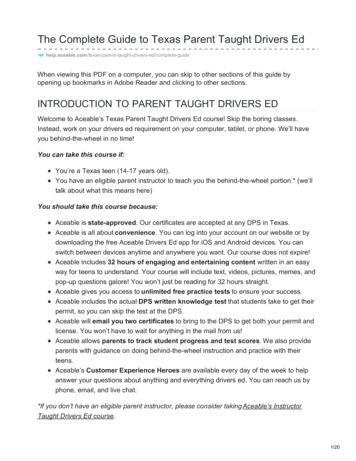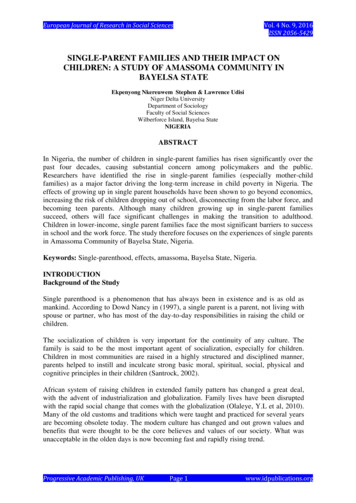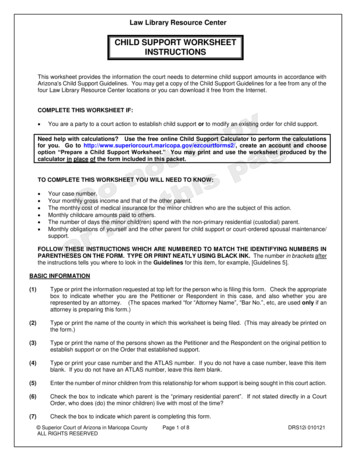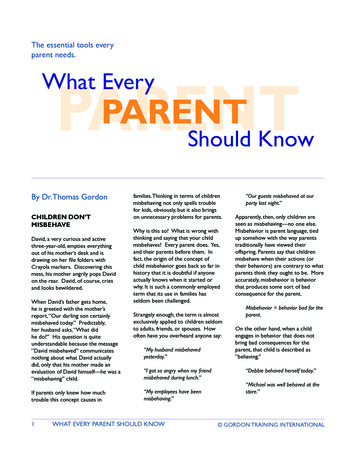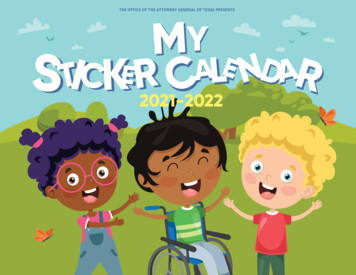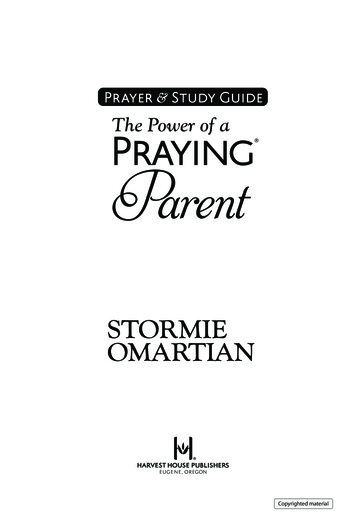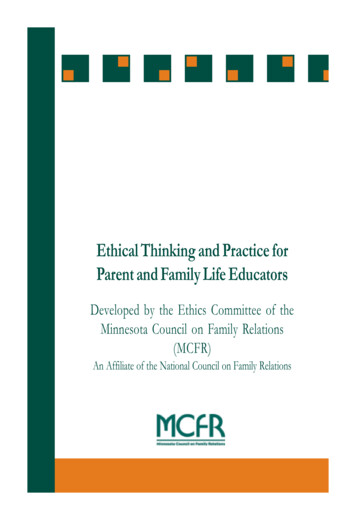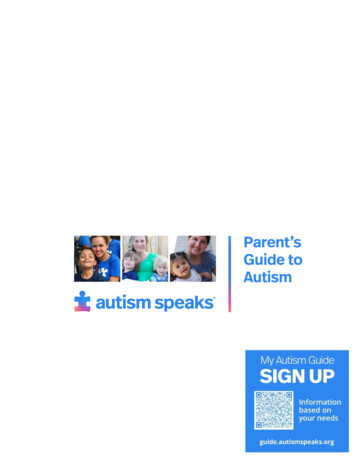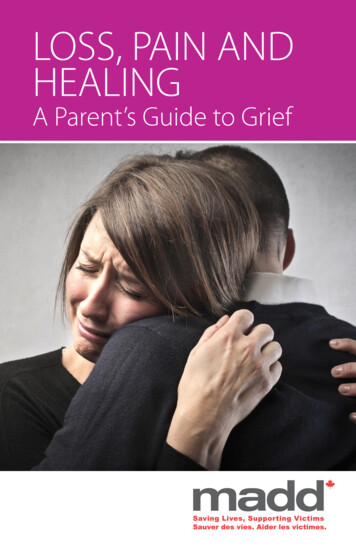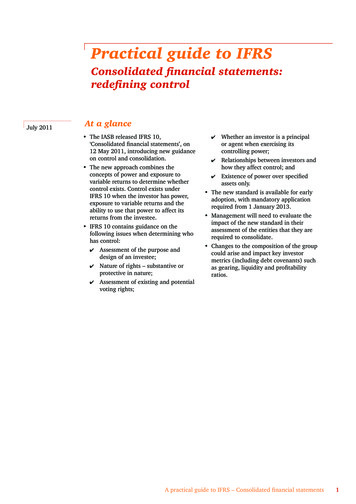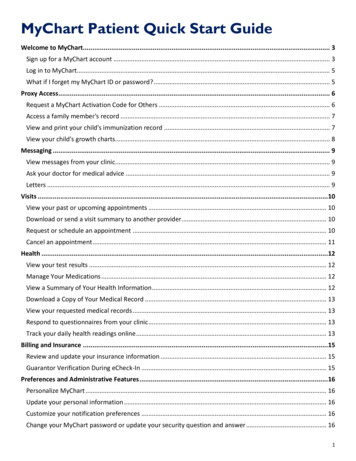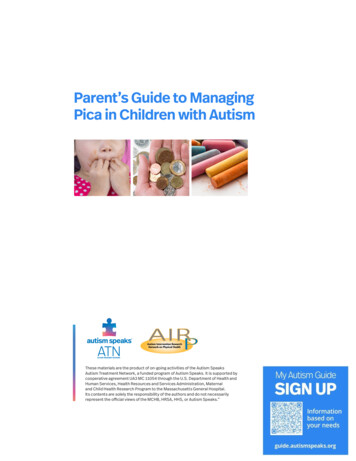
Transcription
Parent’s Guide to ManagingPica in Children with AutismThese materials are the product of on-going activities of the Autism SpeaksAutism Treatment Network, a funded program of Autism Speaks. It is supported bycooperative agreement UA3 MC 11054 through the U.S. Department of Health andHuman Services, Health Resources and Services Administration, Maternaland Child Health Research Program to the Massachusetts General Hospital.Its contents are solely the responsibility of the authors and do not necessarilyrepresent the official views of the MCHB, HRSA, HHS, or Autism Speaks.”
A Parent’s Guide to PICApresented by Autism Speaks ATN/AIR-PPurpose Statement: This tool kit is a guide for parents who have children who eat non-fooditems (pica). It will help parents learn about pica – what it is, why it happens, who to go to for help, andways to try and prevent it.What is Pica?Pica is the repeated eating of things that are not food. It is a common eating problem in children withautism. Children with pica often eat things like paper, plants, plastic or stones. Some children swallowobjects quickly. Other children hold items in their mouths and only swallow them occasionally.Mouthing and swallowing non-food items is common behavior in many babies and toddlers. They do thisas a way to explore and learn. Most children outgrow the behavior by 18 months of age. A child is labeledas having pica only when eating non-food items continues after this age.Common things children with pica mouth or eat: Chalk Cigarette butts Clay Clothing or thread Coins Dirt Feces Hair Large amounts of ice Paint chips Paper Plants or grass Plaster Rocks, pebbles or wood chips Rock salt Rubber bands Shampoo Toys (Legos, Play Doh, Magnetix,figurines and many more)Why is pica a problem?Most children with pica are healthy. This is because many items that children with pica eat are passed inthe stool without problems. However, pica can cause certain health problems that parents should knowabout. When non-food items are eaten in large amounts, they can cause blockages in the stomach.Certain things like glass and rubber bands can cause damage to the stomach and intestines. Otherhealth problems from pica include: High lead levels in the blood from eating items containing lead (e.g., paint chips, etc.)Nutrition problemsPoisoning due to ingestion of common household items such as cleaning productsInfections in the mouth, stomach or intestinesWearing down of the teethChildren with pica may develop problem behaviors(such as anger or aggression)if they are stopped when trying to get wanted items.p.1
A Parent’s Guide to PICApresented by Autism Speaks ATN/AIR-PWhy do children with autism and other developmental disabilities have pica?Several common causes of pica have been identified: The most common cause is sensory feedback (also called automatic reinforcement). Thesechildren eat non-food items to get a pleasurable or enjoyable feeling. Some children have difficulty telling food from non-food items. Some eat non-food items becausethey believe the items are food. Another cause might be low levels of iron or zinc. Children with this problem may be helped withvitamin supplements. These children also might require behavioral treatment.Pica is not usually caused by: Effort to get attention Lack of ability to communicate needsTreatment is more successful when children with pica have a medical and behavioral assessment. Medicaltests can help show if your child has a nutritional need or medical problems caused by pica. Behavioralassessments can help you understand the causes of pica and decide the best way to respond to relatedproblem behaviors (such as aggression or running away).Signs of pica in a child: The child often puts items such as small toys in mouth. He or she searches for items to eat or put in mouth. Non-food items are found in the child’s bowel movement (e.g., string, pebbles or plastic). The child eats food from the floor, trash can or other odd places. He or she has problems telling food from non-food items (e.g., takes a bite out of acardboard coaster when dining out). People who spend lots of time with the child such as his or her teacher or babysitter reportconcerns about pica.If you see one or more of these signs, seek a medical and behavioral assessment.Consider trying the interventions below which do not require professional help.p.2
A Parent’s Guide to PICApresented by Autism Speaks ATN/AIR-PWhere can I go for help?The following people will be able to provide useful information about pica: Behavior analyst with skills in functional behavioral assessment and the development ofbehavioral intervention plans Psychologist with skills in Applied Behavior Analysis (ABA), autism and behavioral functionalassessment Developmental/behavioral pediatrician Dietitian or nutritionist Pediatrician or other primary care providerTHINGS PARENTS CAN DOSome initial steps you can take:1) Keep a list of the items your child eats or mouths. Share this listwith your child’s doctors, teachers or other caregivers.2) Keep track of how often your child displays pica behavior in anotebook.3) Keep a list of the places and situations where your child putsthings in his/her mouth.4) Keep non-food items your child frequently attempts to eat outof his or her sight. Move items to a safe location such as thebasement.5) Put locks on cabinets, closets or doors that contain possiblepica objects.6) Vacuum or sweep floors daily to reduce items on the floor thatyour child might eat.7) Enrich your child’s environment. During down times, provideaccess to things your child likes to do that do not include picaitems.8) Teach danger awareness skills. Have your child practiceidentifying things that are non-edible or dangerous.p.3
A Parent’s Guide to PICApresented by Autism Speaks ATN/AIR-PThings parents can do with some coaching and feedback from professionals:1) Blocking: Blocking is when an adult puts his or her hand on top of the child’s hands to “block”them from putting an item in his or her mouth. This can reduce pica for many children. How andwhen you block is important, though. This is why parents should get help if this is needed. Otherthings to think about include: Use the least amount of force necessary to prevent your child from placing the item in his/hermouth. Try to block before your child gets the item near his or her mouth. Remember that at the start, many children may have a negative response such as aggressionor tantrums. You may need help on how to manage these behaviors2) Skill-building: Teaching your child how to identify food from non-food items can lessen pica.This is usually done using rewards and pictures (called discrimination training). To do this: Have your child sit at a table with a plate on a colored placemat. Put a few non-food items on the table. Put a favorite food on your child’s plate. Reward your child for eating from the plate and not putting the non-food items in his/hermouth.3) Snack scheduling: Make a snack available on a set schedule (every 30 minutes or hour).Tell your child that he/she can have a snack but don’t try to make him/her eat it. More frequentsnacks might provide your child with other options besides non-food items.4) Reward schedule: Give a reward such as a toy for not eating non-food items for a period oftime.5) Teach different behaviors such as picking up pica items and throwing them away orreturning them to their place. Break the skill down into steps and help your child practice eachstep.6) Attend to health issues related to pica: Talk to your child’s doctor or nurse about having his/her iron and zinc status tested. Low levelsof these nutrients can contribute to pica. (ADD LINK to Provider Tool Kit) Provide vitamins or supplements if advised by your child’s doctor or nurse. Talk to your child’s doctor or nurse about testing for lead. Children with pica should have theirlead levels tested regularly. See a nutritionist if your child is on a special diet or is very picky. Make sure your child sees a dentist regularly. Make sure your regular dentist, doctors and nurses know your child has pica. If your child has new health problems, make sure the doctors and nurses caring for him or herknow about the pica.p.4
A Parent’s Guide to PICApresented by Autism Speaks ATN/AIR-PTreatments that require professional helpSome children have pica that cannot be helped by the treatments described above. Sometimes this isbecause the child’s pica is very frequent. Other times the child has a lot of medical difficulties or manybehavior problems that need to be treated. In these cases, families need special help. You likely need aprofessional who has high level skills in working with children with disabilities, pica and other behaviorproblems. The types of treatments that might be used with the help of this professional include: Brief physical restraint (i.e., holding a child’s hands to their sides for a short period of time) Overcorrection (i.e., using physical assistance to help a child pick-up pica items)These interventions require a complete behavioral assessment and on-going treatment planning bya child’s parents and his/her professional team. They require parent consent and should be shown toparents prior to their use.For more information on behavior supports for children with autism, see the Autism Speaks ChallengingBehaviors Tool l-kits/challenging-behaviors-tool-kitp.5
A Parent’s Guide to PICApresented by Autism Speaks ATN/AIR-PRESOURCESThe Autism Speaks Family Services Department offers resources, tool kits, and support to help managethe day-to-day challenges of living with autism www.autismspeaks.org/family-services. If you areinterested in speaking with a member of the Autism Speaks Family Services Team contact the AutismResponse Team (ART) at 888-AUTISM2 (288-4762), or by email at familyservices@autismspeaks.org.ART en español: 888-772-9050.Suggested Readings for ParentsAli, Z. (2001). Pica in people with intellectual disability: A literature review of aetiology, epidemiologyand complications. Journal of Intellectual & Developmental Disability, 26, 205–215.**Glasberg, B. A. (2008). Functional behavior assessments for people with autism. Woodbine Press, ISBN:http://www.woodbinehouse.com.McAdam, D. B., Sherman, J. A., Sheldon, J. B., & Napolitano, D. A. (2004). Behavioral interventions toreduce the pica of persons with developmental disabilities. Behavior Modification, 28, 45–72.**Napolitano, D. A. & McAdam, D. B (2012) Problem Behavior. In Tristram Smith (Ed). Making InclusionWork for Students with Autism Spectrum Disorders: An Evidence-Based Guide. The Guilford Press.ISBN-13: 978-1606239322. http://www.guilford.com.Pace, G. M., & Toyer, E. A. (2000). The effect of a vitamin supplement on the pica of a child with severemental retardation. Journal of Applied Behavior Analysis, 33, 619–622.**Stiegler, L. N. (2005). Understanding pica behavior: A review for clinical and education professionals.Focus on Autism and Other Developmental Disabilities, 20, 27–38.**Thompson, T. (2009). Freedom from meltdowns. Dr. Thompson’s solutions for children with autism.Paul H. Brookes Publishers, ISBN: 978-1-55766-986-5. http://products.brookespublishing.com.Online general nutrition information: http://www.choosemyplate.gov/**Technical article that might require support from professionalsACKNOWLEDGMENTSThis tool kit was developed by members of the Autism Speaks Autism Treatment Network / AutismIntervention Research Network on Physical Health: David McAdam, Lynn Cole, and Linda Howell inthe Division of Neurodevelopmental and Behavioral Pediatrics at the University of Rochester Schoolof Medicine. We would like to thank the parents of the children and the adults with pica with whomwe have worked for teaching us the clinical knowledge contained in this toolkit. We would also liketo thank the parents who provided feedback on the tool kit materials. It was edited, designed, andproduced by Autism Speaks Autism Treatment Network / Autism Intervention Research Network onPhysical Health. We are grateful for review and suggestions by many, including by families associatedwith the Autism Speaks Autism Treatment Network. This publication may be distributed as is or, atno cost, may be individualized as an electronic file for your production and dissemination, so that itincludes your organization and its most frequent referrals. For revision information, please contactatn@autismspeaks.org.These materials are the product of on-going activities of the Autism Speaks Autism Treatment Network,a funded program of Autism Speaks. It is supported in part by cooperative agreement UA3 MC 11054,Autism Intervention Research Network on Physical Health (AIR-P Network) from the Maternal and ChildHealth Bureau (Combating Autism Act of 2006, as amended by the Combating Autism ReauthorizationAct of 2011), Health Resources and Services Administration, Department of Health and Human Serviceto the Massachusetts General Hospital. Its contents are solely the responsibility of the authors and donot necessarily represent the official views of the MCHB, HRSA, HHS. Published May 2014.p.6
Dietitian or nutritionist Pediatrician or other primary care provider 1) Keep a list of the items your child eats or mouths. Share this list with your child's doctors, teachers or other caregivers. 2) Keep track of how often your child displays pica behavior in a notebook. 3) Keep a list of the places and situations where your child puts
